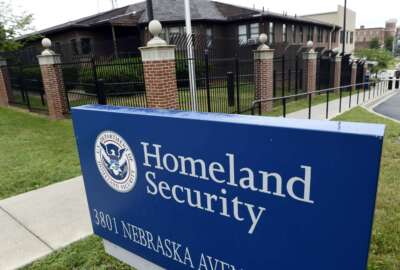A Homeland Security effort to combine requirements has stalled
A Department of Homeland Security (DHS) initiative called "the Joint Requirement Council" hasn't gone very far in 10 years. The Council is supposed to discover...
A Department of Homeland Security (DHS) initiative called “the Joint Requirement Council” hasn’t gone very far in 10 years. The Council is supposed to discover capabilities multiple DHS components have in common, in order to avoid duplication and redundancy. But the Council doesn’t meet very often and no one at the top seems to pay any attention, according to the Government Accountability Office (GAO). For more, Federal Drive with Tom Temin spoke with GAO’s Director of Contracting and National Security Acquisitions, Travis Masters.
Interview Transcript:
Tom Temin Tell us what this Joint Requirements Council specifically is supposed to do. It was formed in relation to a GAO recommendation back in 2014.
Travis Masters Yeah, that’s right, Tom. Actually, it goes even further back than 2014. The JRC was established in 2003, not too long after the Department of Homeland Security became a department and didn’t really function at the time, didn’t have management support and kind of died on the vine. In the 2008 timeframe we made a recommendation that should be reestablished. It was in that 2014 timeframe that they reestablished the Joint Requirements Council and began to put policies and processes in place for the Joint Requirements Council to review capability requirements for the various components within the Department of Homeland Security to do, as you said, identify those areas where they have commonality, things that they could find some efficiencies by pursuing jointly and then make those recommendations to the leadership of DHS to then combine those and fund those jointly to satisfy multiple needs. And so that’s really the intended function. You know, since 2016, roughly 2018, that’s sort of what they’ve been attempting to do. And that’s what this report was looking at.
Tom Temin And what they’re supposed to try to avoid is redundancy in acquisitions. In other words, go to maybe a shared acquisition or a shared services type of model for those capabilities or requirements they have in common.
Travis Masters Yes, that’s correct. Yeah, the duplication. Two different components pursuing the same solution is not an efficient way to do business. And so the hope is that this council can help the department’s components identify those areas where they could gain those efficiencies.
Tom Temin So an example might be, say, unmanned aerial vehicles which Customs and Border Protection might need, the Coast Guard might need. FEMA might even need them for maybe different purposes, but it would be the same functional technology.
Travis Masters Yeah, that’s correct. That is a good example.
Tom Temin Well, have they identified any last few years anyhow?
Travis Masters Yes. So in this report we went back to 2018. That was the scope of the assessment and we found that there were five different areas where they identified some joint capability opportunities. And we took a look at kind of the process that JRC went through to analyze those various joint documents. And we found that largely, you know, the documents didn’t fully meet the requirements process requirements in one sentence. Right. But that the requirements process says they should.
Tom Temin In other words, in establishing a joint requirement, they have a process to do that to make sure that it really fully vetted.
Travis Masters Yeah, that’s correct. So the Joint Requirements Counsel, as they review these documents, are supposed to look at certain aspects of the document, things like, you know, does the documents state the capability need. Clearly there’s the planned capability that stated actually address, you know, a validated need. And one of the areas where they lacked the most was in the area of actually quantifying capability gaps. So doing the actual quantitative analysis or at least providing that analysis in the documents, there were three documents that we looked at that did not fully meet that requirement. And so they had some analysis in there, but it wasn’t to the standards that the policy would require.
Tom Temin So only five even looked at in the past five or six years. And what are the capabilities that they feel that they might have in common? What are they?
Travis Masters Yeah, so those five counter unmanned aircraft systems.
Tom Temin So I’m a good guesser.
Travis Masters Yeah. Well done.
Tom Temin No, actually, I read your report.
Travis Masters DHS Tactical Intelligence, Surveillance and Reconnaissance Network. So a network, persistent wide area, maritime surveillance, immigration data integration and the enterprise Analytic Services process. Those were the five areas.
Tom Temin We’re speaking with Travis Masters, director of Contracting and National Security Acquisitions at the GAO. So clearly, they have to do their paperwork and do their documentation better, and that’s one of your recommendations. But before we get to those, I wanted to ask you, how much attention does this council get from top leadership at DHS who you would presume should be interested in what the JRC is coming up with?
Travis Masters Yeah, that’s a great question, Tom. And over the years, as I noted earlier, you know, they haven’t really gotten a lot of attention when the council was first established in the early 2000. So that was one of the reasons it did not succeed. There wasn’t a lot of management attention. The same is true now. The Deputies Management Group, that’s the point organization for the JRC to report to, and the JRC are supposed to interact with each other on a regular basis, providing direction and guidance, and then the JRC then would provide recommendations for funding and prioritization of requirements. And that interaction just hasn’t been happening. And it goes both ways. Both organizations have not interacted with each other like they should. And that was one of our primary findings and led to a recommendation that they should establish an annual process for ensuring these interactions take place.
Tom Temin It gets back to the fundamental problem in government is there is no budget for donuts and so nobody gets good meetings. And what about the idea too that you’ve identified that they want to make that the people on the Council or DHS leadership would change to whom that council reports from a notch to a notch lower than it reports now.
Travis Masters Yeah, that’s correct. So that was one of our recommendations as well. So DHS is planning to move the Joint Requirements Council from its current location where it reports directly to the undersecretary for management. So it has a relatively independent position which provides it some authority and the ability to affect things if in fact, they’re having those meetings and moving the information, as we just discussed, to another position lower than that and put it under the Chief Readiness Support Officers organization within DHS. And that organization, when we looked across if they were going to move it under an organization, that was probably the least relevant one to put it under. And the DHS folks actually did some analysis to that. The team discovered and talked to them about where their analysis found a similar thing. It was not the highest or the best location for this, but they’re moving it there. And our concern is that they’ll lose their independence and maybe even whatever pull they have.
Tom Temin Right. So GAOs opinion is that they need more autonomy and a little bit more authority and influence, not less. The JRC.
Travis Masters Yes, that’s correct. Yep.
Tom Temin So you’ve recommended, you know, they do their documentation and identify and quantify the actual requirements better. That would be joint. And also that they meet at least and get together and talk about things at least once a year. I would think they’d want to talk about it monthly, but that’s just me. What are your other chief recommendations here?
Travis Masters So those are two big ones. We want the JRC and the Deputies Management Action Group, as I mentioned, to meet regularly. That’s a big one. The other two really are related to your last point about the movement of the organization within the management structure. We want them to reconsider this move of the JRC under the Chief Readiness Support Officer, and we want them also to take a look at the JRC staffing and whether or not they have the appropriate number of people with the appropriate skills within that Joint Requirements Council. DHS concurred with all of our recommendations, but the plan for those final two, the move of the organization and the workforce issues, they plan to do the reassessment after they move the organization. And our recommendations were pretty clear that those should be done prior to making the move so that the analysis that supports those could be in hand as they make those final decisions.
Tom Temin Because when you really think about it, one that is observing DHS could come up with a bunch of ideas for joint requirements. I can think of cloud computing, for example, like the Defense Department has been struggling and now they’re finally there with that. Or on financial management, there’s a lot of information, technology and services that clearly the components could share. So it seems like there’s plenty of ideas. They just need to get their act together.
Travis Masters Yeah, that’s absolutely right. There are other ways that this could be done. Potentially. Our key point though, for that would just simply be that we want to make sure that the direction they go will allow the JRC to maintain independence and have that direct influence in order to be able to function the way it’s intended to, to help prioritize joint requirements so that those needs get met across the department.
Copyright © 2025 Federal News Network. All rights reserved. This website is not intended for users located within the European Economic Area.
Tom Temin is host of the Federal Drive and has been providing insight on federal technology and management issues for more than 30 years.
Follow @tteminWFED






